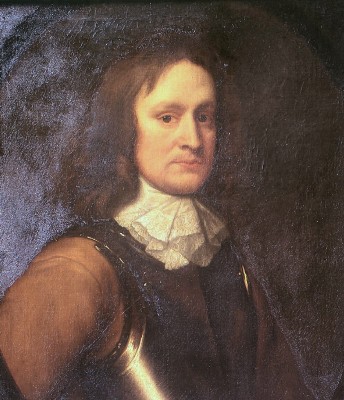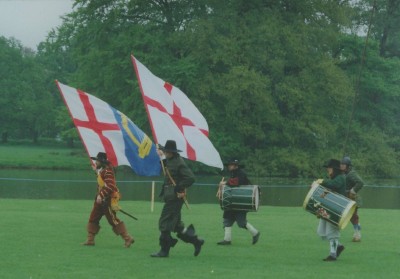
John Hampden, cousin to Oliver Cromwell, was born in 1595, son of a wealthy, influential Buckinghamshire family. He was educated at Thame Grammar School 1600-09, graduating to Magdalen College, Oxford 1609-13, and the Inner Temple of London, finally entering the House of Commons in 1621, where he became a 'taxation' specialist.
In 1625, he was selected M.P. for Wendover and two years later was imprisoned for a year, for refusing to contribute to a forced loan demanded by King Charles I. When Hampden's close friend, Sir John Eliot, died in 1632 after three years' confinement in the Tower, his ill will for the King was sealed. He resisted the payment of 'ship money' - a tax imposed by the King for the outfitting of his Navy. In 1635, Hampden refused to pay 20/- ship tax and the case was referred to the judges of the Court of the Exchequer. On 12 June 1638 seven of the judges upheld for the King and five for Hampden, causing widespread rebellion to the tax and causing him to be regarded as "The most popular man in all England".
During the Long Parliament of November 1640 he became the principal lieutenant of the Parliamentary leader John Pym in a vigorous attack on Royal policies, and was one of the 'five birds' who successfully 'flew the Chamber' in January 1642 and evaded arrest by the King.
The King left London on 10th January, and on the 11th the Five Members returned to Westminster to a tumultuous welcome. Parliament continued to sit and when the King refused to sign the Militia Bill - giving Parliament power over the Militia - Parliament, with Hampden's guidance, passed the Militia Ordinance.
Aware of the inevitability of war, John Hampden, now the Deputy Lieutenant for Buckinghamshire, and Colonel Arthur Goodwin, set about the task of recruiting what was to become one of the best and longest serving Parliamentarian regiments.
THE GREENCOATS
On 22nd August 1642, Charles I raised his standard at Nottingham and in so doing declared war upon Parliament. In command of the Parliamentary army was Robert Devereux, Earl of Essex, but he was no military genius. Chances were lost and the King's forces gathered strength. The regiment raised by John Hampden was soon to become known for its religious fervour and strict discipline, even singing psalms when marching into battle. The regiment was issued with uniforms of green cloth - said to be chosen as it was the livery of the Hampden family servants, green also regarded as having the significance of "good hope or honourable action". Not only was Hampden personally wealthy, but Parliament controlled all the major arsenals; Hampden contributed £2,000 of his own money and also received 17/- (85p) per man from Parliament. Thus the Greencoats became one of Parliament's best equipped regiments.


In late October the regiment was given the task of Escort to the Trayne of Artillary, but on the 23rd at the Battle of Edgehill, they arrived too late to affect the course of the battle. Slowed down by seven heavy cannon, the brigade reached the field at the time of Prince Rupert's charge which had swept the Parliamentarian infantry's left wing from the field. On 12th November the regiment was present at Brentford when Rupert sacked it, but once more arrived too late to prevent Brooke's and Holles' regiments from being severely cut up.
In January 1643 the regiment numbered 893, and saw much action throughout the year, including the siege of Reading. On the 18th June, during a battle with Prince Rupert's cavalry at Chalgrove near Oxford, John Hampden was wounded. Some sources claim that he was hit in the shoulder by a bullet during the fight, but others have stated that his own pistol exploded in his hand. The injury was fatal and after riding across country he reached Thame, where he died a week later.
The regiment, by June numbering 849, survived its commander's death, unlike many others, and Coll. Tyrill assumed command. In 1645, the regiment was absorbed into the New Model Army under the command of Coll. Ingoldsby, the future regicide and when the Restoration finally took place in 1660 the Regiment of John Hampden "The Patriot" was still in existence.
c. 1989
